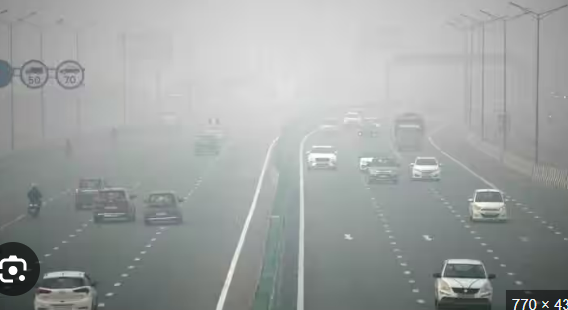Delhi air quality drops to ‘severe’, odd-even an option as GRAP-IV curbs return

NEW DELHI, DEC 17 : After a brief respite from bad air, Delhi’s air quality index (AQI) slipped to the ‘severe’ category yet again with a reading above 400 as authorities imposed GRAP-IV restrictions in a bid to curb worsening pollution levels.
Of the city’s 37 monitoring stations, 26 of them had AQI readings beyond the 400-mark. The worst affected areas were Jahangirpuri (466), Anand Vihar (465) and Bawana (465). The pollution levels have spiked in the last few days due to low wind speeds which are not enough to clear the pollutants and low temperatures, with the minimum temperature remaining below 5 degrees Celsius for the past two days.
Severe AQI levels were also observed in key areas including Rohini (462), Lajpat Nagar (461), Ashok Vihar (456), and Punjabi Bagh (452), all of which reported readings over 400. On Monday, the AQI had slipped to the ‘very poor’ category at 306, higher than Saturday (December 14), which was at the higher end of the ‘poor’ category.
In response to the deteriorating air quality, the Commission for Air Quality Management (CAQM) had implemented GRAP-III plan earlier. This set of actions were aimed at curtailing air pollution through measures such as stopping construction activities and increasing public awareness about limiting outdoor exposure. But now, with the AQI touching the ‘severe’ level owing to highly unfavourable meteorological conditions, the CAQM Sub-Committee on GRAP called for an emergency meeting and decided to impose GRAP-IV restrictions in Delhi-NCR with immediate effect.
Under GRAP-IV restrictions, entry of non-essential trucks into Delhi is prohibited, except for those carrying essential commodities or providing essential services. However, LNG/CNG/electric and BS-VI diesel trucks are allowed to enter Delhi. Delhi-registered BS-IV vehicles and below, diesel-operated Medium Goods Vehicles (MGVs) and Heavy Goods Vehicles (HGVs) and Light Commercial Vehicles (LCVs) registered outside Delhi are not permitted in the city. According to the plan, schools and colleges in Delhi and NCR are mandatorily required to shift classes to online mode.
All construction and demolition activities are banned, including those for linear public projects such as highways, roads, flyovers, overbridges, power transmission, pipelines and telecommunications. Additional emergency measures may be considered, such as closing schools and colleges, closing non-emergency commercial activities, and implementing odd-even vehicle restrictions based on registration numbers. The CAQM has also advised the central government to consider staggered timings for its offices in Delhi-NCR to further reduce vehicular emissions.
Meanwhile, the Delhi Airport also issued an advisory amidst the low visibility in Delhi, saying, “Low visibility procedures are in progress at Delhi Airport. All flight operations are presently normal. Passengers are requested to contact the airline concerned for updated flight information.”
The forecast for the coming days suggests that meteorological conditions will not be conducive for dispersing the pollutants in Delhi. The IMD has predicted calm winds combined with high humidity, factors that contribute to the stagnation of pollutants in the atmosphere. It has forecast dense to moderate fog or smog for Tuesday, which could further exacerbate the pollution levels.
Calling pollution a “pan-India” issue, the Supreme Court earlier today asked the government to submit a list of highly polluted cities. The court said a machinery similar to CAQM should be created for all states.
Before the GRAP-IV measures came into being, the air quality panel had invoked GRAP-II restrictions in Delhi-NCR since December 12.
Stages of GRAP are invoked by the panel based on the AQI of the capital region. Stage-I of the GRAP is invoked when the AQI is 201 to 300, which falls under ‘poor’ category, while Stage-II is invoked when the air quality is ‘very poor’ (AQI 301-400). Similarly, Stage-III of the GRAP is invoked when the AQI is 401 to 450, which falls under ‘severe’ category, while Stage-IV is invoked when the AQI breaches the 450-mark.
-PTI






